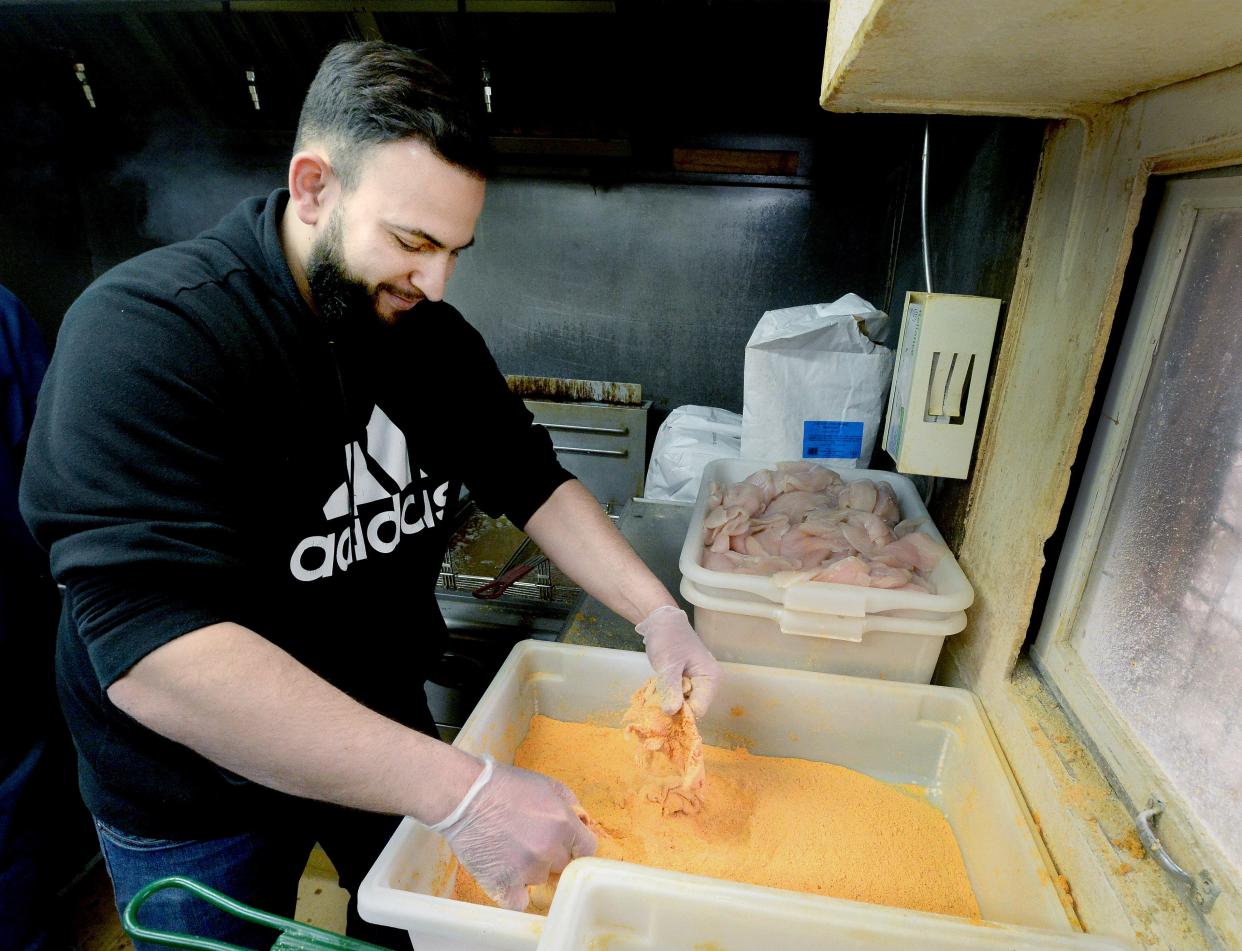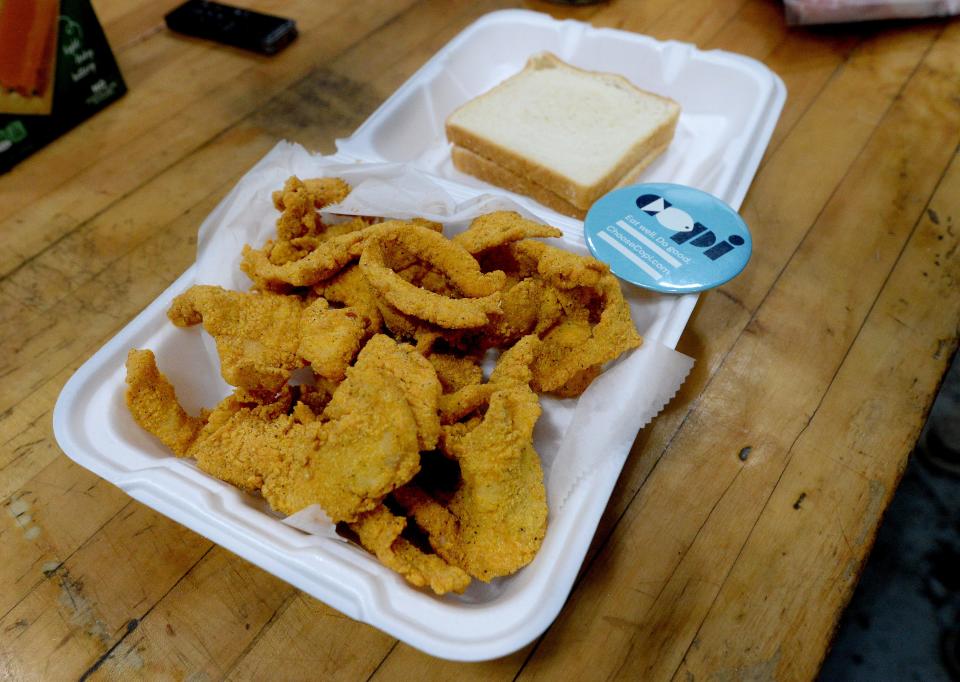One year on from its great re-branding, here's how Copi is doing locally

- Oops!Something went wrong.Please try again later.
When Clint Carter began going out at the age of 10 to find fish for his family's market on South Grand Avenue East, he noticed a group of species that he initially hated, due to the fact that he and his family were wasting time trying to find good product for the market, only to find an invasive species.
"When we started this business, our family sold buffalo and we caught them," Carter said. "In the early 1990s on the Mississippi River, they showed up in big numbers, but we were told not to release it. They had graveyards of them on the banks. That right there is why I originally hated them because they were a lot of work for nothing."
That group was Asian carp, the series of four freshwater species that have become a nuisance in waterways across the United States over the past 20 years and threaten the Great Lakes. Many a strategy has been tried to prevent these fish from affecting the natural ecosystem in these bodies of water, from using sounds and building barriers to paying people bounties to eliminate the species in local waters.
The state of Illinois, on the other hand, is trying something different. Last year, as part of a national initiative, the Illinois Department of Natural Resources began calling Asian carp "Copi", a play on the word copious and a reference to the vast number of carp swimming in state waters.
More: Illinois State Fair Grandstand tickets go on sale March 31
The mission is a simple one: to get people to get these fish out of the waterways and into people's stomachs. Overseeing this mission is Kevin Irons, the assistant chief of fisheries for IDNR, who arrived in the state of Illinois in 1991 and noticed a lot of the same sort of things that Carter did as a child at the same time.
"The (Asian) carp has been here as long as I have," Irons said. "In 1991, a commercial fisherman on the Illinois River brought them in, 'What is this?' Through the '90s, we were part of a broad fish monitoring program out of Havana (and) we got what we called 'onesies' and 'twosies'. Either a fisherman would bring them in or we started picking them up. We would do electrofishing and all other kinds of nettings to get a comprehensive look at the fish community."
As the decade continued, more and more Asian carp began swimming in the Illinois River, with commercial fishermen having to discard them while looking for the catfish or buffalo they so desired. The discarded carp created scenes where so many of them were piled up, rotting along the banks of the river with no use for them whatsoever.
"For commercial fishermen, their catches (of Asian carp) were increasing more rapidly," Irons said. "We would see piles of bighead carp and silver carp on the side of the river because there wasn't much of a market for them. They were trying to look for catfish or buffalo and these would be a nuisance in their catch and they couldn't do anything with them, so they would pile up."
By the start of the next decade, the Asian carp that had made the Illinois River home began to procreate and cause even more problems for fishermen trying to find product in that area. Instead of dealing with just a handful of fish, Irons said that his commercial fisherman friends now had to deal with thousands of invasive fish interfering with the natural habitat of the area.
"On the Illinois River, we were quickly able to realize that this could be a problem," Irons said. "Because we were monitoring the fish, we started paying some extra attention to which fish could be affected the most – things like gizzard shad, who eat the same kind of food (and) they don't grow nearly as big, but they're the native forage for our piscivores, and big-mouth and small-mouth buffalo.
I took that personally as research (into) what is going on here. The first few years, they started getting thinner. That led me to a publication about the condition of these fish in 2007 and some of the first evidence that they are affecting these native fish."
By 2010, Irons moved over to IDNR, where he considered what to do about this invasive species. His inspiration for trying to cull the population of Asian carp by eating it came from seeing other fish species become delicacies through creative name changes.
"Orange roughy and Chilean seabass, their (original) names didn't encourage their consumption," Irons said. "This is something that has been utilized in the past and it was something ripe for us in Illinois."
Much like how fisheries in the 1970s determined that "orange roughy" was a more attractive name than "slimehead" and "Chilean seabass" was more marketable than "Patagonian toothfish", Irons and his team at IDNR realized that in order to get people to eat the fish, they would need to change the name in order to make it attractive.
Not that people hadn't tried finding a new name before then. Carter started selling Asian carp as a delicacy at his market years prior to IDNR's effort to promote the fish, referring to it as "silverfin" thanks to a Baton Rouge, Louisiana-based chef who trademarked the name.
Even with the new name, Carter still had to sell skeptical customers on buying the fish. Once they were told by him of what the fish actually was, they were shocked to discover that it tasted good.
"These fish had been bastardized in the media because of these issues of taking over the Great Lakes and worry about taking over lakes and local waterways," Carter said.
Of course, "silverfin" didn't catch on quite as well as it did down in the bayou, but IDNR quickly got to work after a 2017 study indicated that a name change was needed to successfully rebrand the fish.
They went out to fish markets across the state, such as Carter's Fish Market, to get their ideas on what to do with the name and how to market it to the public, assisted by a Chicago-based marketing firm. While several names were bandied about, it was Copi that ended up being the one chosen, with 21 retailers – including Carter's – committing to putting it on their menus and selling it at their markets.
Even with the backing of the state of Illinois, Irons said that it remains a challenge to try and get people to try Copi, in large part because it's so new and because people are skeptical about actually putting the fish in their mouths.
"People like what they like," Irons said. "We've had those square fish sandwiches or the frozen stuff out of the freezer, that's what we like. Anything new to the ballgame, it's like, 'Why do we want that? Isn't that the fish that we're supposed to hate? A lot of people have tried to brand the fish as something we've got to get rid of – and we do – for environmental concerns, so why would I eat that thing?'"
More: Police say Springfield man was stabbed to death during home invasion
So why is Copi something that people would like to eat? According to Irons, it's a clean, tender and flaky meat perfect for fish fries and has enough versatility to be used in empanadas and Rangoon.
"It's so mild, it's not fishy at all," Irons said. "You can flavor it up like a taco meat and it will taste like taco meat. It doesn't get in the way of any of those flavors. It's so flexible in how you use it when processed correctly. It won't even taste like fish."
Carter said that Copi checks all the boxes you want in a modern fish: it's sustainable, it's green and it's healthy. At the market, Carter sells frozen strips that one can thaw and cook as they please, in addition to the empanadas and the Rangoon. He's developed a practice for stripping the bones off the fish in order to make more attractive to people who don't want to deal with pesky bones.
"We came up with a way (to debone) practicing with them," Carter said.

Outside the store, there is a small food truck that sells breaded and fried Copi in the traditional strips, similar to a catfish. Carter is even working with a Michigan-based supplier who provides a creamy Copi dip to serve with crackers and chips.
Ensuring that the product remains on the shelf is a challenge for him, however. Carter sees the big picture in trying to ensure that Copi isn't clogging up waterways, but outside of selling 2-3 cases a week, business is a bit slow.
Still, he knows that there's plenty of room for Copi to grow in the hearts and minds of people and initiatives like selling it, if it can be processed quicker to get more product onto the shelves. It also doesn't hurt that restaurants like the Curve Inn and Weebles Bar and Grill have sold Copi in various ways, such as the empanadas.
"We're creating the demand with the restaurants," Carter said. "Delivery is an issue now and processing is another issue. It's gonna go. With the younger generation, it checks all the right boxes (and) it's the right thing to do. I don't have any doubt, here or globally. It has plenty of uses."
Helping to get Copi to the restaurants is Carter's good friend Trevor Miller, owner of Big Red's Bait and Tackle in Springfield. Carter refers to Miller as a "foodie" and "influencer" who is working to promote the fish in restaurants. Miller extols the virtues of a fish he originally found as a good, tasty bait for other fish, such as catfish.
"It's a little denser white meat than the pollock that we're having around town for our walleye dinners," Miller said. "It has a pretty neutral flavor, it doesn't have a heavy fish flavor or anything. The only problem is those bones and they're working their way around them."
Irons still feels as if IDNR is taking baby steps to promote the product, with much of the heavy lifting coming from people like Carter and Miller. The need to continue to build up the supply lines hasn't gone unnoticed by Irons, who feels that it's important to ensure that the fish can get to the restaurants and markets as quickly as possible.
"Most of our emphasis has been at the highest level of distributors and consumers at a large level," Irons said. "The next phase is to help them get out to the restaurants and we've got some local mouthpieces that have been very effective at knocking on the doors of restaurants because this is the right thing to do."
This article originally appeared on State Journal-Register: Here's how Copi is doing one year after the state rebranded Asian Carp

